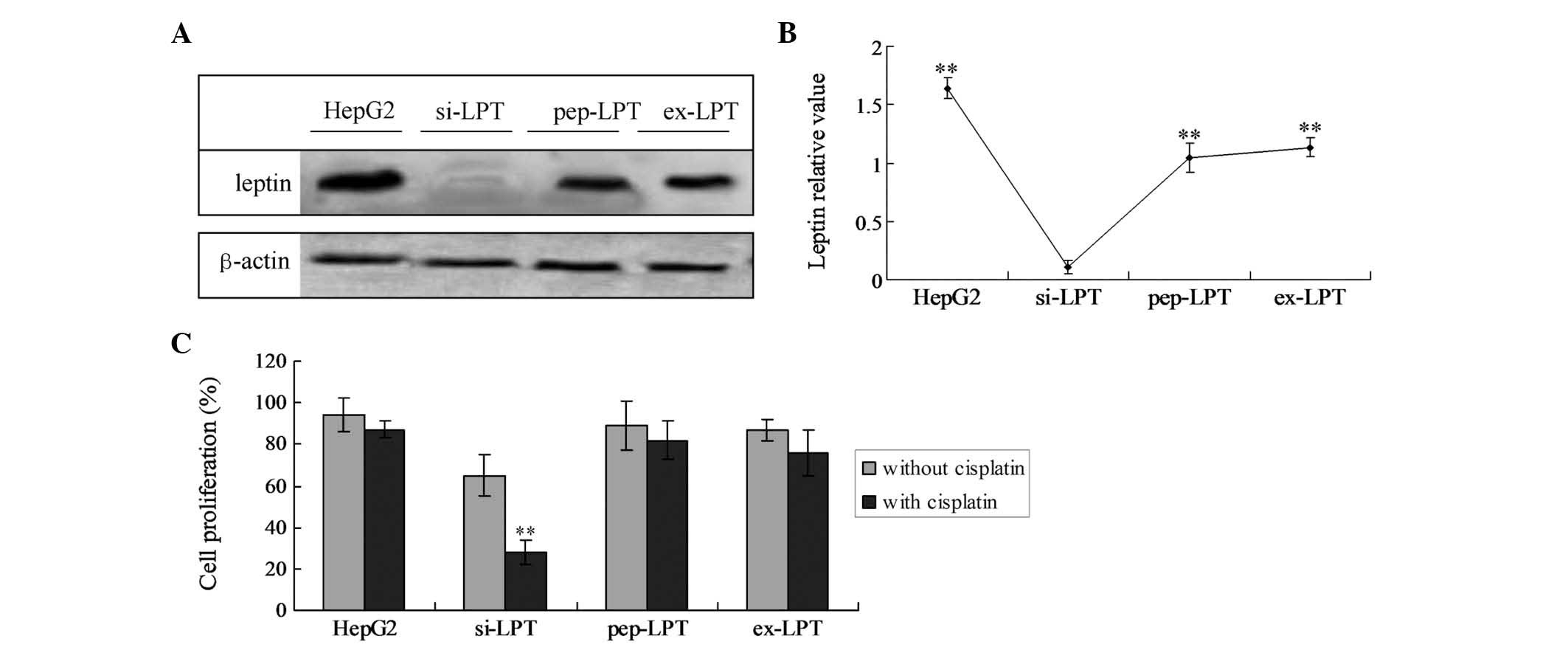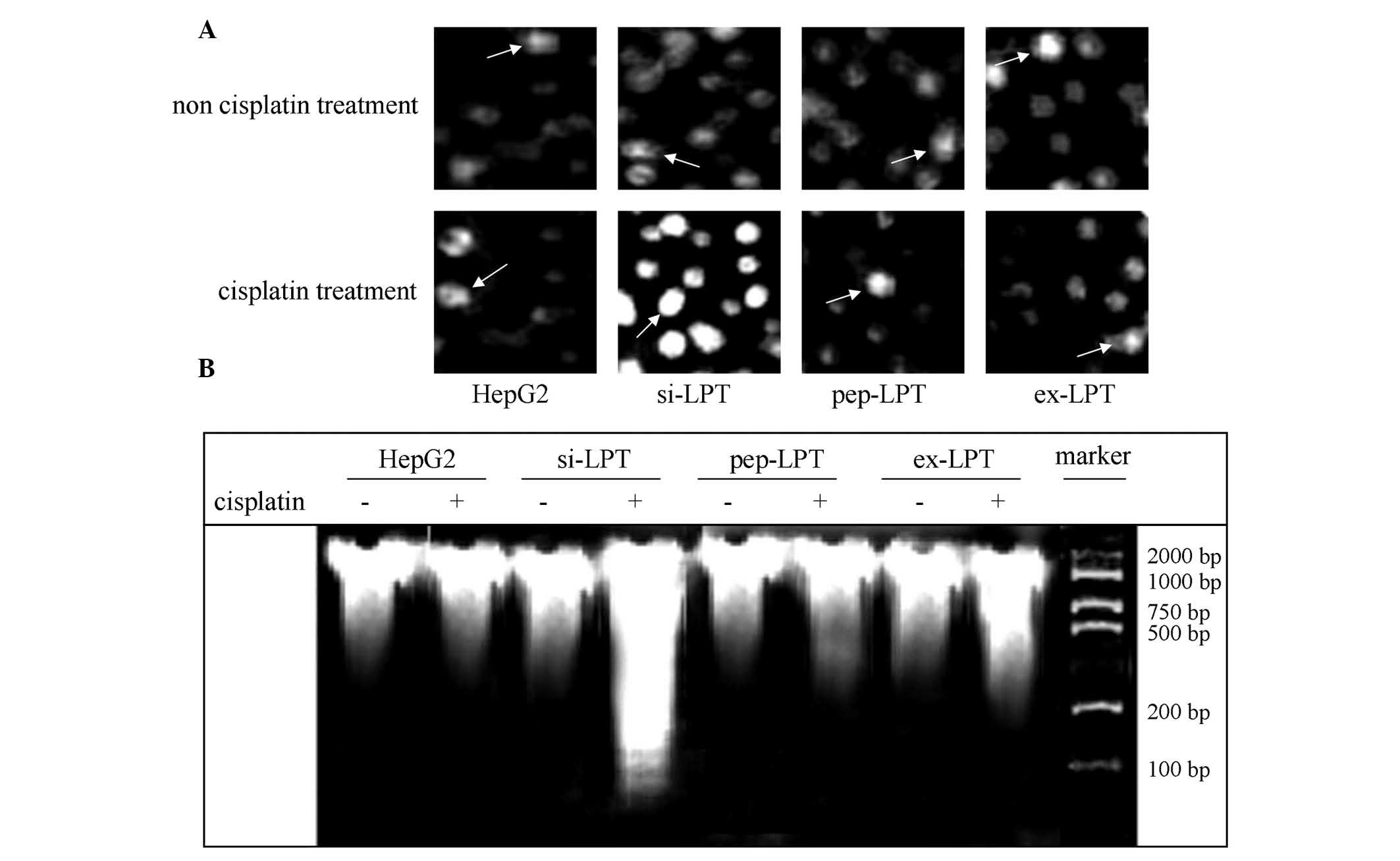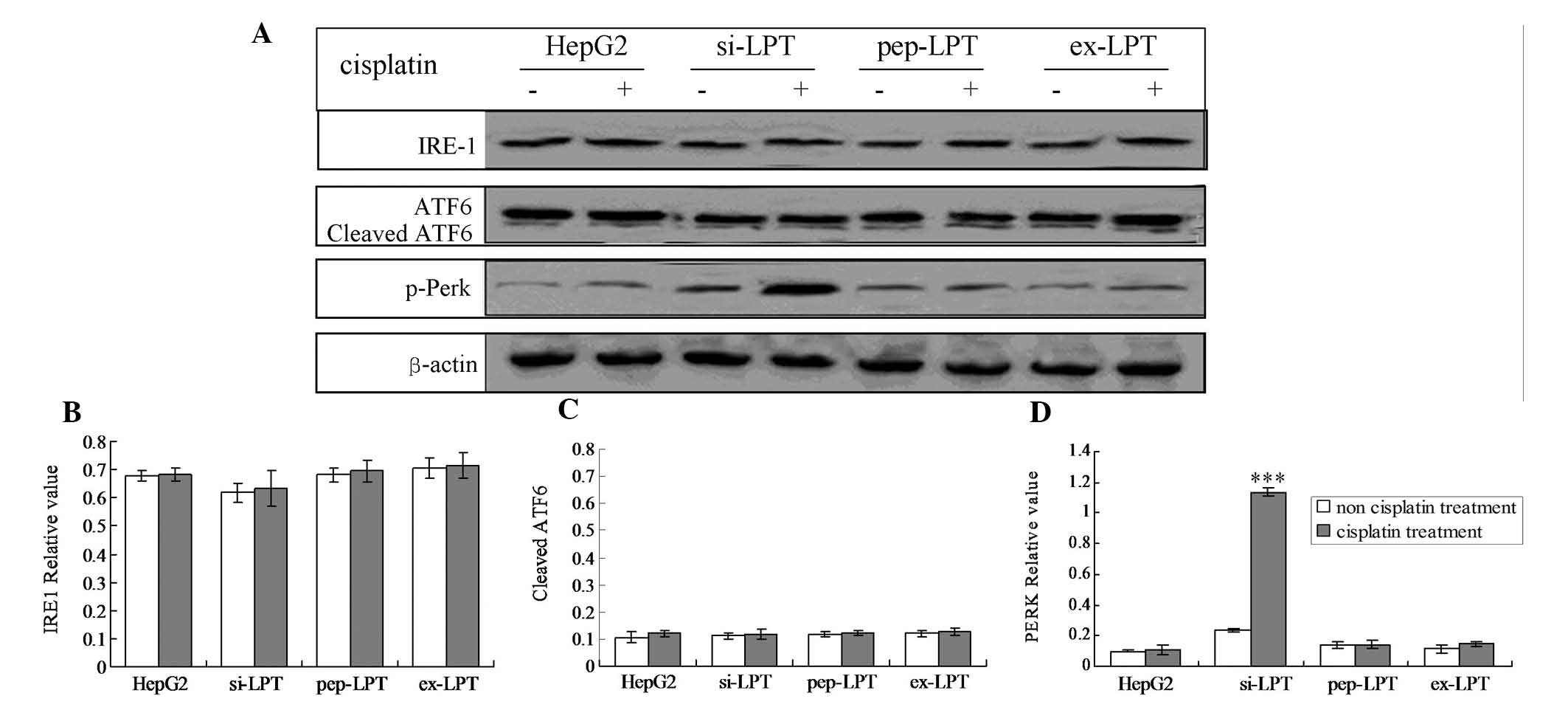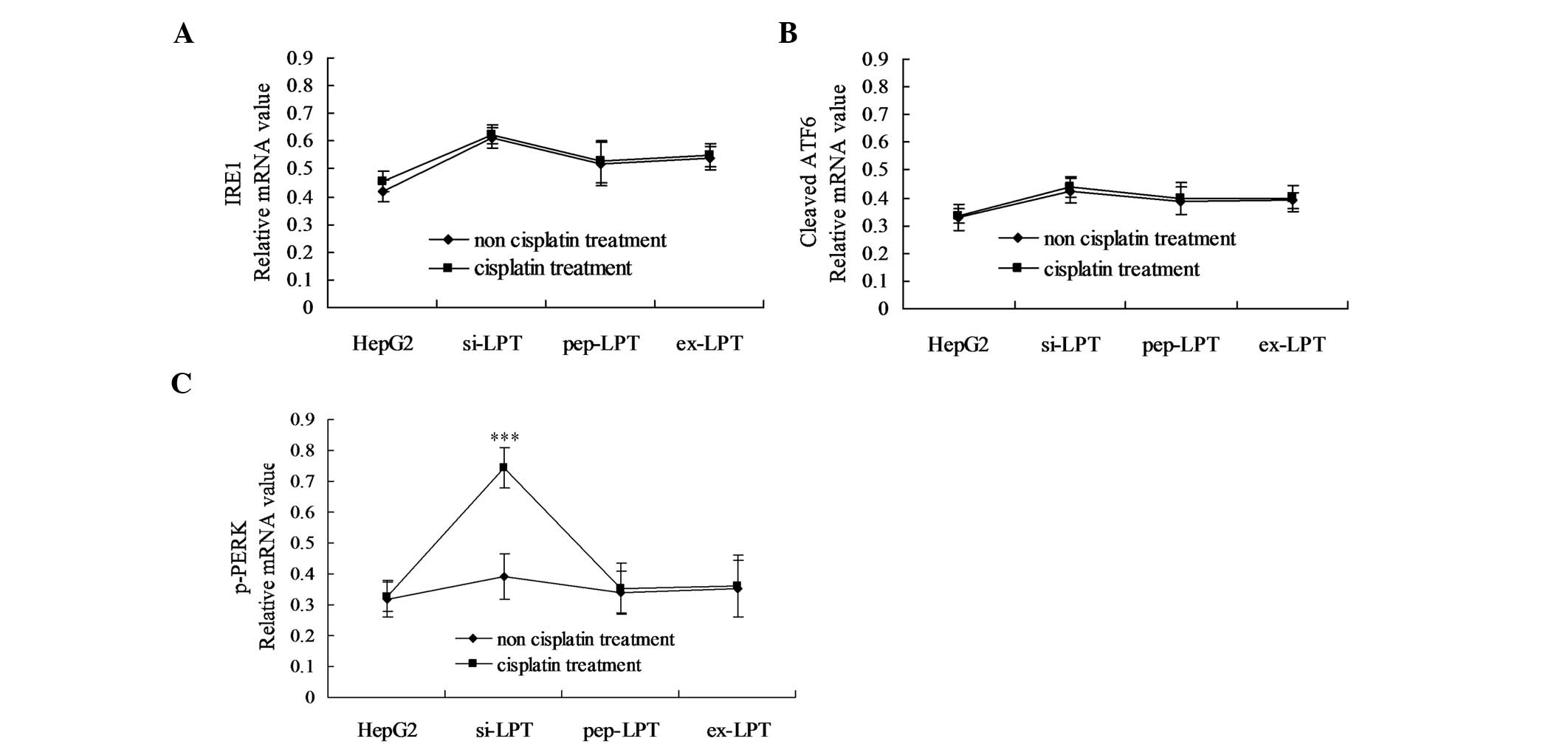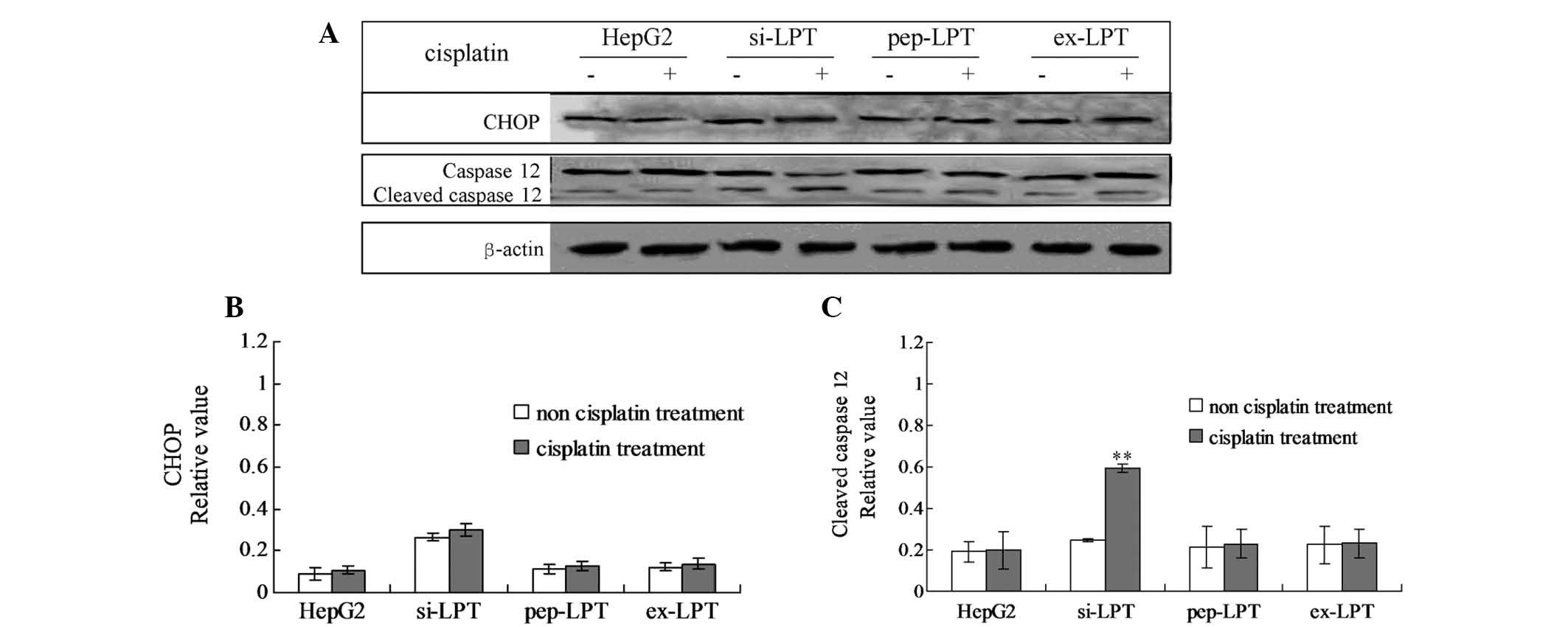Human leptin protein activates the growth of HepG2 cells by inhibiting PERK‑mediated ER stress and apoptosis
- Authors:
- Published online on: July 14, 2014 https://doi.org/10.3892/mmr.2014.2373
- Pages: 1649-1655
Abstract
Introduction
Hepatic cancer is a cancer that originates in the liver. Liver cancer is a malignant tumor that grows on the surface or inside of the liver. Several types of liver tumor have been identified using medical imaging equipment or presented symptomatically as an abdominal mass, abdominal pain, jaundice, nausea or liver dysfunction (1,2). Liver cancer differs from liver metastases, which is a type of cancer that originates from organs elsewhere in the body and migrates to the liver. Liver cancer commonly develops resistance to radiation and chemotherapy and often presents at stages too late for surgical intervention. Since current treatment modalities are inadequate, novel therapies are required to treat the various types of liver cancer, which have an increasing incidence (3). Therefore, identifying targets for liver cancer is becoming increasingly valuable for the development of novel methods for therapy.
The endoplasmic reticulum (ER) is an organelle found in eukaryotic cells that forms an interconnected network of membrane vesicles (4). The ER is involved in lipid synthesis, protein folding and maturation and can be affected by a variety of toxic insults (5,6). Increasing evidence has verified that ER stress is involved in the regulation of apoptosis, particularly in ER stress-associated apoptosis (4–6). ER stress triggers several specific signaling pathways, including ER-associated protein degradation and the unfolded protein response (UPR) (4,7,8). The UPR pathway includes the inositol requiring protein 1 (IRE1) pathway, the PKR-like ER kinase (PERK) pathway and the activating transcription factor 6 (ATF6) pathway (9). All the above three UPR pathways are able to activate the apoptosis associated pro-apoptotic response, including C/EBP homologous protein (CHOP)/GADD153 and caspase 12, which finally induces apoptosis.
Leptin is a 16-kDa protein hormone that is important in regulating energy intake and expenditure, including appetite, hunger, metabolism and behavior (10). Furthermore, leptin is a pleiotropic hormone with proliferative and anti-apoptotic roles. Several studies over the past few years have suggested that leptin/leptin receptor dysregulation is important in the development of various types of malignancy, including lung (11), breast (12), gastric (13) and thyroid cancer (14). However, the anti-apoptotic effect and specific mechanisms underlying the role of leptin in liver cancer remain to be elucidated. The present study established an understanding of the anti-apoptotic mechanism of the leptin protein in liver cancer.
Materials and methods
Cell culture and transfection
The human normal liver cell line HL-7702 and the hepatocellular carcinoma cell line HepG2 were purchased from ATCC (Manassas, VA, USA). The two cell lines were maintained in Dulbecco’s modified Eagle’s medium (DMEM; Gibco-BRL, Carlsbad, CA, USA) with 15% fetal bovine serum (HyClone, Logan, UT, USA) and cultured at 37°C with 5% CO2. Different quantities of plasmids (Invitrogen Life Technologies, Carlsbad, CA, USA) were transfected into the monolayer cells with Lipofectamine™ 2000 transfection reagent (Invitrogen Life Technologies). The cells were harvested with trypsin/EDTA (Biyuntian, Beijing, China) in phosphate-buffered saline (PBS) 24 h post transfection, pelleted by short centrifugation and suspended in lysis buffer as previously described (15).
Leptin plasmid construction and leptin peptide synthesis
The leptin gene was amplified using the polymerase chain reaction (PCR) technique, using the cDNA of human adipocyte cells isolated from the subcutaneous fat of a patient (the patient who provided the subcutaneous fat signed the approved written informed consent form prior to the present study). The samples were obtained from The Second Affiliated Hospital of Nanchang University. The present study was approved by the ethics committee of The Second Affiliated Hospital of Nanchang University (Nanchang, China). The primer sequences used were as follows: leptin, forward 5′-GCGAATTCATGGTTCCAATCCAAAAAGTCCAAG AGG-3′ and reverse 5′-TATGGATCCTCAGCACCCAGG GCTGAGG-3′. The PCR product was subcloned into the pcDNA3.1(+) vector, yielding the recombinant plasmid pcDNA3.1-ex-LPT. Different quantities of plasmids (2 μg DNA per well in a 6-well plate and 0.2 μg DNA per well in a 96 plate) were transfected into the monolayer cells. The other procedures were performed as described previously (15).
The human leptin peptide was synthesized according to the following sequence: ASN-VAL-ILE-GLN-ILE-SER-ASN-ASP-LEU-GLU-ASN-LEU-ARG, pep-LPT (Sigma, St. Louis, MO, USA). The human leptin peptide (100 nm) was transfected into BEAS2B cells 4 h prior to treatment with or without cisplatin.
Small interfering RNA (siRNA) transfection
siRNA against human leptin (si-LPT) were synthesized by Invitrogen Life Technologies. Transient transfection was performed using Lipofectamine™ 2000 transfection reagent according to the manufacturer’s instructions. HepG2 cells were seeded into six-well plates for RNA or protein preparation and 96-well plates for DNA fragmentation or cell growth assays (HepG2-si-LPT). Following 24 h incubation, the media were replaced with serum-free RPMI-1640 containing siRNA (100 nmol/l) and transfection reagent. The experiments were repeated at least three times.
Western blot analysis
All the lysates extracted from the cells were separated by 15% SDS-PAGE and electro-transferred onto nitrocellulose membranes. The nitrocellulose membranes were inhibited with 5% skimmed milk in PBS overnight at 4°C. The membranes were then incubated with 1:3,000 mouse anti-human leptin-specific monoclonal antibody (mAb; Santa Cruz Biotechnology, Inc., Santa Cruz, CA, USA), 1:1,000 goat anti-human CHOP pAb (Stressgen, San Diego, CA, USA), 1:2,000 mouse anti-human p-PERK mAb (Stressgen), 1:4,000 mouse anti-human ATF6 mAb (Stressgen), 1:3,000 mouse anti-human IRE1 mAb (Santa Cruz Biotechnology, Inc.), 1:2,000 mouse anti-human full length and mouse anti-human spliced caspase 12 mAb (Stressgen), 1:3,000 anti-human CHOP mAb (Santa Cruz Biotechnology, Inc.) and 1:1,000 mouse anti-human β-actin mAb (Santa Cruz Biotechnology, Inc.) for 2 h at room temperature. The membranes were then incubated with 1:4,000 horseradish peroxidase-conjugated anti-mouse, 1:1,000 anti-rabbit or anti-goat immunoglobulin G (Santa Cruz Biotechnology, Inc.). The reactive signals were visualized using an enhanced chemiluminescence kit (PE Applied Biosystems, Foster City, CA, USA).
Cell proliferation detection
A 2,3-bis-(2-methoxy-4-nitro-5-sulfophenyl)-2H-tetrazolium-5-carboxanilide (XTT) assay was employed to measure the cell proliferation using a cytotoxicity detection kit (Sigma). Different quantities of plasmids (2 μg DNA per well in a 6-well plate and 0.2 μg DNA per well in a 96 plate) were transfected into the monolayer cells. Briefly, 24 h after transfection, the cell activity in each well was detected according to the manufacturer’s instructions. The 96-well plate was read at 490 nm on an ELISA plate reader (MK3; Thermo Fisher Scientific, Waltham, MA, USA). Each analysis was performed twice in at least six wells.
Detection of apoptosis
In the present study, flow cytometric analysis, DNA fragmentation and terminal deoxynucleotidyl transferase dUTP nick end labeling (TUNEL) assays were employed to detect apoptosis. Apoptosis was detected by flow cytometric analysis that monitored annexin V-fluorescein isothiocyanate binding and propidium iodide uptake simultaneously according to the manufacturer’s instructions (Sigma). The samples were analyzed by fluorescence on a FACScan flow cytometer (Beckman Coulter, Miami, FL, USA). DNA fragmentation in the cells was determined by the DNA-laddering technique as previously described (15). Potential DNA fragmentation was examined using the TUNEL apoptosis detection kit (Chemicon, Temecula, CA, USA).
RNA extraction and semi-quantitative reverse transcription PCR (RT-PCR)
For mRNA detection of p-Perk, IRE1 and ATF6, a series of semi-quantitative RT-PCR assays were performed. The specific primers were synthesized according to previous studies (Table I) (16–18). In parallel, individual β-actin was selected as the internal control. With an RNAsimple Total RNA kit (Tiangen, Beijing, China), total cellular RNA was prepared. Reverse transcription and RT-PCR were performed using the SuperScript™ III First-Strand Synthesis System (Invitrogen Life Technologies) according to the manufacturer’s instructions. Following electrophoresis on 1.5% agarose gel, the gel images of each PCR product were digitally captured with a CCD camera (Canon EOS T3i; Canon, Tokyo, Japan) and analyzed with the NIH Imager β version 2 (Bio-Rad Gel Documentation System 2000; Bio-Rad, Hercules, CA, USA). The relative transcriptional values of each factor in semi-quantitative RT-PCR are presented as the ratio of the signal value of the specific PCR product and that of the individual β-actin.
Statistical analysis
Quantitative analysis of immunoblot images was performed using the computer-assisted software Image Total Tech (Pharmacia, St. Paul, MN, USA). Briefly, the image of the immunoblot was scanned using a Typhoon laser scanner (Typhoon 8600; Amersham Pharmacia Biotech, Pompano Beach, FL, USA), digitalized and saved in the TIF format. The average gray value of each preparation was calculated by the gray numerical value of each blot vs. that of β-actin. Average data of each preparation were evaluated from three independent blots and are presented as the mean ± standard deviation. Statistical analysis was performed using Student’s t-test. P<0.05 was considered to indicate a statistically significant difference.
Results
Expression of leptin protein
In the preparations of HepG2 cells, high levels of intrinsic leptin were detected. The incubation with leptin peptide (pep-LPT) and expression of leptin (ex-LPT) also generated high levels of leptin in HL-7702 cells. In si-LPT cells, no significant leptin bands were detected (Fig. 1A and B). Furthermore, intrinsically expressed leptin levels in the HepG2 cells were significantly higher compared with the incubated or expressed leptin in the pep-LTP and ex-LPT groups (Fig. 1B; P<0.05).
Leptin expression triggers liver cell proliferation
XTT analysis revealed that no significant differences in proliferation and viability among the HepG2, pep-LPT and ex-LPT groups treated with and without cisplatin were present (Fig. 1C). However, when the si-LPT group was treated with cisplatin, the proliferation viability significantly decreased as compared with the group treated without cisplatin (Fig. 1C; P<0.001).
Leptin inhibits cell apoptosis
Cell apoptosis was detected by TUNEL and DNA ladder analysis in the present study. The TUNEL results indicated that cisplatin was not able to affect the apoptosis of HepG2, pep-LPT and ex-LPT cells expressing or accumulating leptin protein (Fig. 2A). In the si-LPT group, cisplatin treatment was able to significantly induce apoptosis compared with the group that was not treated with cisplatin (Fig. 2A). Clear DNA ladders in agarose electrophoresis gels were observed in the cells in which the leptin expression was inhibited following treatment with cisplatin (Fig. 2B). This indicated that the expression of leptin in normal liver cells was able to inhibit apoptosis.
The PERK UPR pathway is involved in the inhibition of leptin-triggered apoptosis
The three main UPR factors of ER stress, PERK, IRE1 and ATF6, were analyzed by western blot analysis and RT-PCR analysis, respectively. The results demonstrated that the expression of leptin inhibited the phosphorylation of PERK (Fig. 3A–C). Therefore, the quantity of p-PERK was not triggered by the treatment of cisplatin in the HepG2, pep-PLT and ex-PLT groups (Fig. 3A–C). However, in the si-PLT group, the phosphorylation of PERK was significantly increased when treated with cisplatin (Fig. 3D; P<0.001).
Additionally, the mRNA of the above UPR proteins was analyzed using semi-quantitative RT-PCR 12 h after transfection. As shown in Fig. 4, following treatment with cisplatin, the mRNA levels of p-PERK significantly increased in the preparations of the si-LPT group as compared with the groups not treated with cisplatin (Fig. 4C; P<0.05). Notably, no significant differences in IRE1 and cleaved ATF6 were identified between the HepG2, pep-LPT and ex-LPT groups in the presence and absence of cisplatin (Fig. 4A and B).
Leptin protein inhibits cleaved caspase 12-induced apoptosis
In order to examine the specific pathway of leptin-induced inhibition of apoptosis, the cellular levels of cleaved caspase 12 and the CHOP protein were evaluated by individual western blot analysis (Fig. 5A). In the cells that were not treated with cisplatin, no changes in the caspase 12 and CHOP protein were identified in any of the groups (Fig. 5B and C). No significant differences were identified in CHOP protein levels in the cisplatin-treated cells compared with the cells that were not treated with cisplatin in all the groups (Fig. 5B). Following treatment with cisplatin, the levels of cleaved caspase 12 in preparations of si-LPT were significantly higher than those in the groups that were not treated with cisplatin (Fig. 5C). However, no changes in cleaved caspase 12 were identified in cells in the presence or absence of cisplatin in the HepG2, pep-LPT and ex-LPT groups (Fig. 5C). The results indicated that CHOP was activated in the si-LPT cells and triggered apoptosis.
Discussion
Although a few studies have examined the association between cancer and the leptin protein (19–22), the present study is the first one, to the best of our knowledge, that investigated the specific mechanism underlying the effects of the leptin protein on apoptosis in the HepG2 cell line. The normal human liver cell line, HL-7702, was able to evade cisplatin-induced apoptotic effects when expressing the leptin protein. The present study demonstrated that leptin inhibits apoptosis through the PERK pathway and inhibits apoptosis or enhances cell proliferation by inhibiting the activation of caspase 12.
Levels of intrinsically expressed leptin in HepG2 cells and extrinsically expressed leptin in HL-7702 cells were examined. The results indicated that all the groups expressed the leptin protein, however, the levels of leptin in HepG2, pep-LPT and ex-LPT cells were significantly higher compared with that in the si-LPT cells. It is known that the malignant transformation of cancer requires continuous cell growth and the inhibition of apoptosis. Thus, cell proliferation in the HepG2, pep-LPT, ex-LPT and si-LPT groups was assessed. The results demonstrated that cell proliferation was significantly enhanced in the cells expressing leptin. Therefore, it was hypothesized that the increased cell proliferation in the HepG2, pep-LPT and ex-LPT cells was due to the inhibition of apoptosis. A previous study also indicated that leptin was associated with apoptosis mediated by oxidative stress (23). In the present study, ER stress was involved in apoptosis.
In order to investigate the specific mechanism underlying cell proliferation in leptin-expressing cells, the levels of ER stress (UPR pathway)-associated proteins, including p-PERK, IRE1 and cleaved ATF6, were detected. The present study revealed that the levels of p-PERK protein and mRNA were activated in the si-LPT group cells following treatment with cisplatin. Thus, the PERK pathway may be involved in leptin-induced inhibition of apoptosis. The leptin-induced inhibition of apoptosis may further elucidate the role of leptin in cancer progression. Previous studies have demonstrated that the activation of PERK was able to phosphorylate eukaryotic initiation factor 2, which was able to activate apoptosis (24). The data indicated the emergence of ER stress following treatment with cisplatin in si-LPT cells. Notably, the expression of leptin inhibited cisplatin-induced ER stress in pep-LPT, ex-LPT and HepG2 cells. Therefore, the present study hypothesized that the leptin protein may be involved in the pathogenic process of liver cancer.
ER stress-associated factors (cleaved caspase 12 and CHOP protein) were detected to identify the specific apoptotic factors that leptin inhibited. According to a study by Wang et al (25), cleaved caspase 12 is able to activate caspase 3 and trigger apoptosis, and CHOP can directly induce ER stress-associated apoptosis. In the present study, no significant changes in the CHOP protein (activated) were identified in all the groups (P>0.05) when treated with cisplatin. Notably, following treatment with cisplatin, cleaved caspase 12 levels in the si-LPT group were significantly increased compared with cells that were not treated with cisplatin (P<0.05); however, no changes in the HepG2, pep-LPT and ex-LPT groups were identified. The above results, indicate that the leptin in liver cells was able to indirectly inhibit caspase 12 protein cleavage, leading to apoptosis. The activation of caspase 12 inhibits cell proliferation by an apoptosis-associated mechanism (26,27). The present study indicated that leptin was able to inhibit CHOP-induced ER stress.
In conclusion, the present study suggested that leptin promotes the growth of HepG2 liver cancer cells through inhibiting the ER stress-mediated pathway. This inhibition is triggered by the p-PERK and ATF6 pathway through inhibiting the expression of CHOP.
Acknowledgements
The present study was supported the Chinese National Natural Science Foundation (no. 91029720).
References
|
Wang Y, O’Connor M, Xu Y and Liu X: Symptom clusters in Chinese patients with primary liver cancer. Oncol Nurs Forum. 39:E468–E479. 2012. View Article : Google Scholar : PubMed/NCBI | |
|
Li Y, Huang X, Zhang Q and Ma K: Phosphorylation of cMet tyrosine residues in murine ascetic hepatic cancer cell lines with different lymph node metastatic potentials. Mol Med Rep. 8:655–661. 2013.PubMed/NCBI | |
|
Yang X, Zu X, Tang J, Xiong W, Zhang Y, Liu F and Jiang Y: Zbtb7 suppresses the expression of CDK2 and E2F4 in liver cancer cells: implications for the role of Zbtb7 in cell cycle regulation. Mol Med Rep. 5:1475–1480. 2012.PubMed/NCBI | |
|
Xu C, Bailly-Maitre B and Reed JC: Endoplasmic reticulum stress: cell life and death decisions. J Clin Invest. 115:2656–2664. 2005. View Article : Google Scholar : PubMed/NCBI | |
|
Moenner M, Pluquet O, Bouchecareilh M and Chevet E: Integrated endoplasmic reticulum stress responses in cancer. Cancer Res. 67:10631–10634. 2007. View Article : Google Scholar : PubMed/NCBI | |
|
Zhang X, Zhang HQ, Zhu GH, Wang YH, Yu XC, Zhu XB, Liang G, Xiao J and Li XK: A novel mono-carbonyl analogue of curcumin induces apoptosis in ovarian carcinoma cells via endoplasmic reticulum stress and reactive oxygen species production. Mol Med Rep. 5:739–744. 2012. | |
|
Banjerdpongchai R, Punyati P, Nakrob A, Pompimon W and Kongtawelert P: 4′-Hydroxycinnamaldehyde from Alpinia galanga (Linn) induces human leukemic cell apoptosis via mitochondrial and endoplasmic reticulum stress pathways. Asian Pac J Cancer Prev. 12:593–598. 2011. | |
|
Choi EJ and Kim T: Equol induced apoptosis via cell cycle arrest in human breast cancer MDA-MB-453 but not MCF-7 cells. Mol Med Rep. 1:239–244. 2008.PubMed/NCBI | |
|
Hung JY, Hsu YL and Ni WC: Oxidative and endoplasmic reticulum stress signaling are involved in dehydrocostuslactone-mediated apoptosis in human non-small cell lung cancer cells. Lung Cancer. 68:355–365. 2010. View Article : Google Scholar : PubMed/NCBI | |
|
Brennan AM and Mantzoros CS: Drug insight: the role of leptin in human physiology and pathophysiology - emerging clinical applications. Nat Clin Pract Endocrinol Metab. 2:318–327. 2006. View Article : Google Scholar : PubMed/NCBI | |
|
Duru S, Sönmez Z, Saygideğer Y, Sever O, Onal B and Ardiç S: The relationship between stage and tumor type and serum leptin level and leptin expression on tumor tissue in lung cancer. Tuberk Toraks. 59:427–428. 2011.(In Turkish). | |
|
Yerlikaya A, Altikat S, Irmak R, Cavga FZ, Kocacan SA and Boyaci I: Effect of bortezomib in combination with cisplatin and 5-fluorouracil on 4T1 breast cancer cells. Mol Med Rep. 8:277–281. 2013.PubMed/NCBI | |
|
Dong Z, Xu X, Du L, Yang Y, Cheng H, Zhang X, Li Z, Wang L, Li J, Liu H, Qu X and Wang C: Leptin-mediated regulation of MT1-MMP localization is KIF1B dependent and enhances gastric cancer cell invasion. Carcinogenesis. 34:974–983. 2013. View Article : Google Scholar | |
|
Zhang GA, Hou S, Han S, Zhou J, Wang X and Cui W: Clinicopathological implications of leptin and leptin receptor expression in papillary thyroid cancer. Oncol Lett. 5:797–800. 2013.PubMed/NCBI | |
|
Wang X, Dong CF, Shi Q, Shi S, Wang GR, Lei YJ, Xu K, An R, Chen JM, Jiang HY, Tian C, Gao C, Zhao YJ, Han J and Dong XP: Cytosolic prion protein induces apoptosis in human neuronal cell SH-SY5Y via mitochondrial disruption pathway. BMB Rep. 42:444–449. 2009. View Article : Google Scholar : PubMed/NCBI | |
|
Shuda M, Kondoh N, Imazeki N, Tanaka K, Okada T, Mori K, Hada A, Arai M, Wakatsuki T, Matsubara O, Yamamoto N and Yamamoto M: Activation of the ATF6, XBP1 and grp78 genes in human hepatocellular carcinoma: a possible involvement of the ER stress pathway in hepatocinogenesis. J Hepatol. 38:605–614. 2003. View Article : Google Scholar | |
|
Lee do Y, Lee KS, Lee HJ, Kim do H, Noh YH, Yu K, Jung HY, Lee SH, Lee JY, Youn YC, Jeong Y, Kim DK, Lee WB and Kim SS: Activation of PERK signaling attenustes Aβ-mediated ER stress. PLoS One. 5:e104892010. | |
|
Lee H, Noh JY, Oh Y, Kim Y, Chang JW, Chung CW, Lee ST, Kim M, Ryu J and Jung YK: IRE1 plays an essential role in ER stress-mediated aggregation of mutant huntingtin via the inhibition of autophagy flux. Hum Mol Genet. 21:101–114. 2012. View Article : Google Scholar : PubMed/NCBI | |
|
Zhang S, Zhang Q, Zhang L, Li C and Jiang H: Expression of ghrelin and leptin during the development of type 2 diabetes mellitus in a rat model. Mol Med Rep. 7:223–228. 2013.PubMed/NCBI | |
|
Gribovskaja-Rupp I, Kosinski L and Ludwig KA: Obesity and colorectal cancer. Clin Colon Rectal Surg. 24:229–243. 2011. View Article : Google Scholar | |
|
Vansaun MN: Molecular pathways: adiponectin and leptin signaling in cancer. Clin Cancer Res. 19:1926–1932. 2013. View Article : Google Scholar : PubMed/NCBI | |
|
Lai Q and Sun Y: Human leptin protein induces proliferation of A549 cells via inhibition of PKR-Like ER kinase and activating transcription factor-6 mediated apoptosis. Yonsei Med J. 54:1407–1415. 2013. View Article : Google Scholar : PubMed/NCBI | |
|
Shen Y, Wang Q, Zhao Q and Zhou J: Leptin promotes the immune escape of lung cancer by inducing proinflammatory cytokines and resistance to apoptosis. Mol Med Rep. 2:295–299. 2009.PubMed/NCBI | |
|
Kimball SR and Jefferson LS: Induction of REDD1 gene expression in the liver in response to endoplasmic reticulum stress is mediated through a PERK, eIF2α phosphorylation, ATF4-dependent cascade. Biochem Biophys Res Commun. 427:485–489. 2012.PubMed/NCBI | |
|
Wang X, Shi Q, Xu K, Gao C, Chen C, Li XL, Wang GR, Tian C, Han J and Dong XP: Familial CJD associated PrP mutants within the transmembrane region induced Ctm-PrP retention in ER and trigger apoptosis by the ER stress in SH-SY5Y cells. PLoS One. 6:e146022011. View Article : Google Scholar | |
|
Wu CT, Weng TI, Chen LP, Chiang CK and Liu SH: Involvement of caspase-12-dependent apoptotic pathway in ionic radiocontrast urografin-induced renal tubular injury. Toxicol Appl Pharmacol. 266:167–175. 2013. View Article : Google Scholar : PubMed/NCBI | |
|
Yang X and Huang N: Berberine induces selective apoptosis through the AMPK-mediated mitochondrial/caspase pathway in hepatocellular carcinoma. Mol Med Rep. 8:505–510. 2013. |



